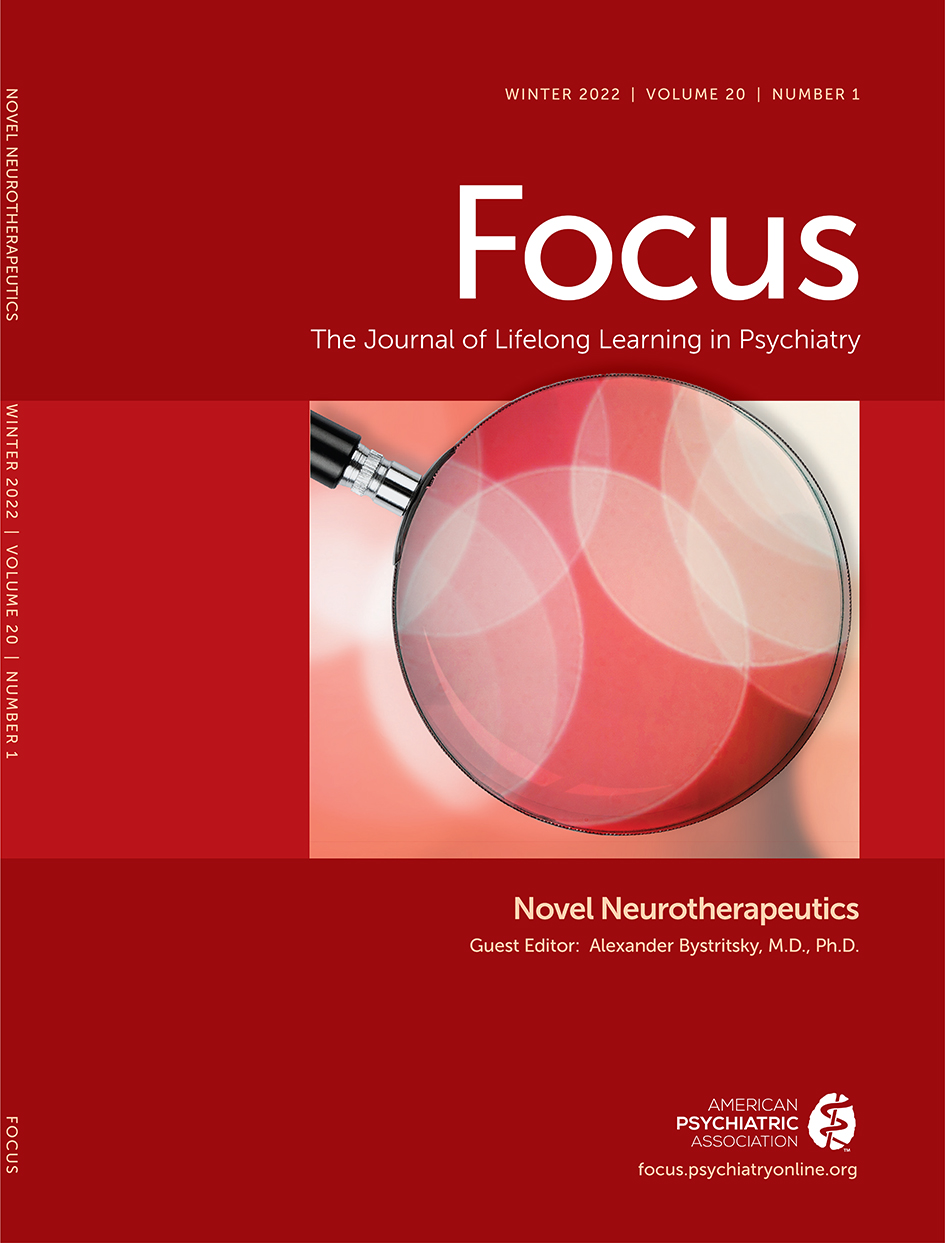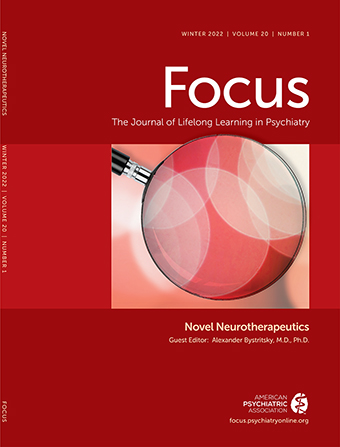The biological psychiatry research landscape suddenly looks better than it has in decades. For a few years, academic researchers and the pharmaceutical industry looked into new receptors and molecules without huge success. Pharmaceutical companies resorted to producing and obtaining Food and Drug Administration (FDA) approval for several products that were technically variations of former ones, with only some improvements in their side-effect profiles. These products were met with resistance by the health insurance industry, which preferred cheaper, generic drugs over those newly FDA approved, despite them mimicking successful remedies from past decades. Many aspiring medications proposing new mechanisms of action failed, losing billions of dollars to pharma companies, and investments into new drugs dwindled down. Some well-known companies even left the psychiatric markets. As a result, biological psychiatry stagnated as a whole.
This has changed ever since the end of the first decade of the millennium, when genetics, neuroimaging, psychedelics, and neuromodulation became the new leading areas of research. As a result, we are entering the third decade of the 21st century with a broad spectrum of new tools to study and treat mental health. This also corresponds with a huge increase in the prevalence of mental disorders and better acceptance of them by society, press, and individuals, which creates unprecedented optimism that soon we can treat individuals with mental illness as we never have before.
This issue of Focus examines improvements in our understanding of mental illness through advancements in brain stimulation, or circuit-based, rather than synaptic-based, treatments. In this issue, several scientists and clinicians review the current knowledge of the field and discuss promising new techniques and technologies to further develop the treatment of psychiatric disorders.
This issue features Drs. Badran and Austelle’s article, “The Future Is Noninvasive: A Brief Review of the Evolution and Clinical Utility of Vagus Nerve Stimulation,” which discusses the technique of stimulating the vagus nerve peripherally with subsequent effects on the central subcortical nuclei. This has had recent revival in psychiatric research and clinical practice and is now gaining traction due to recent data as well as new, noninvasive devices capable of administering vagus nerve stimulation through the skin.
Dr. Katherine Marder and colleagues also provide a great article on “Psychiatric Applications of Repetitive Transcranial Magnetic Stimulation.” Repetitive transcranial magnetic stimulation (rTMS) has become an acceptable and reimbursable strategy for treatment-resistant depression. Health insurance companies have started approving these treatments for patients with significant constraints. Recently, the FDA approved rTMS for obsessive-compulsive disorder (OCD), anxiety, and smoking cessation. Many recent treatment and research strategies address targeting specific circuits for depression and other pathologies, such as tinnitus and pain, as well as treatment duration, and stimulation patterns. In general, rTMS has developed into a very exciting field of noninvasive brain stimulation.
The article “Deep Brain Stimulation for Intractable Obsessive-Compulsive Disorder and Treatment-Resistant Depression” by Drs. Borron and Dougherty provides a thorough historical review of the use of deep brain stimulation (DBS) for psychiatric disorders. DBS is an invasive procedure that requires implanting electrodes in the deep area of the brain. Several new techniques have been recently developed, including better targeting and closed-loop stimulation. However, the only FDA-approved use of DBS to treat psychiatric illness exists for OCD, which is due to a Humanitarian Device Exemption. Mixed results are reported in clinical trials for depression. Due to risks associated with the invasive surgical procedures in the brain, the technique is reserved for exceptionally treatment-resistant patients. However, information from recordings of implanted electrodes is very valuable for better understanding circuit-based treatments.
In “Transcranial Electrical Stimulation for Psychiatric Disorders in Adults: A Primer,” Dr. Hyein Cho et al. review different types of electrical stimulation strategies and mechanisms. Some techniques discussed offer inexpensive home-based treatments that are potentially effective for certain psychiatric disorders.
Additionally, the article “Ultrasound as a Neurotherapeutic: A Circuit- and System-Based Interrogation,” by Norman Spivak and colleagues, reviews an emerging field of focused ultrasound pulses that can be delivered to the deep nuclei of the brain under MRI or functional magnetic resonance imaging (fMRI) guidance. The advantages of this technology are depth that reaches thalamic areas, tight focus, and fMRI feedback that permits brain mapping in real time. The technique is capable of excitation and inhibition of the brain circuits. Recent clinical evidence highlights the potential efficacy on anxiety, pain, disorders of consciousness, and epilepsy. The field of transcranial low-intensity focused ultrasound pulse still needs a lot of research spanning from targeting to intensity parameters, but it can offer a huge advantage of noninvasive deep brain stimulation for the circuit-based treatment of mental disorders.
In his article, “Brighten the Future: Photobiomodulation and Optogenetics,” Dr. Li-Da Huang reviews emerging fields of optogenetics that use pointed laser beams to activate synapses and substances within the brain. This technique is invasive and mostly used in animal research. However, it may have significant future implications for psychopharmacology in which local activation of pharmacological agents could offer therapeutic advantages. The author reviews another technique that utilizes high-intensity lasers at specific frequencies that reach deep through the skull to specific areas of the brain. This technique is very early in its development but promises another way of treating brain circuits.
The theme of targeting brain circuits is also included in “A Systematic Approach to Neuropsychiatric Intervention: Functional Neuroanatomy Underlying Symptom Domains as Targets for Treatment,” by Dr. Taylor Kuhn and colleagues. This article discusses the recent data from different neuroimaging projects and databases, such as the Human Connectome Project, and critically discusses their association with psychiatric syndromes. Knowledge of the current state of brain circuit neuroimaging is extremely important for future understanding of psychiatric disorders and their circuit-based treatment.
“Noninvasive Delivery of Biologicals to the Brain,” by Dr. Sheldon Jordan et al., provides an important interface of pharmacological, bio-immunological, and brain stimulation techniques. Recent studies examine techniques like transcranial focused ultrasound (tFUS), which could increase permeability or reversibly open the blood-brain barrier. Limited animal and human studies have demonstrated that the drugs, nanoparticles, or biologicals could be delivered to the focal point of brain circuits, separated from the carrier vehicle, and, in some cases, activated. This could open an opportunity for collaboration between device and pharmaceutical industries. Many pharmaceutical companies’ prototype drugs (such as peptides) failed because of poor bioavailability. If tFUS and other techniques can deliver or augment the drug effect within specific nuclei or circuits, they might increase drug effectiveness and decrease side effects.
I believe that the future of psychiatry is bright. The selected authors of these articles are mostly at the beginnings of their careers. They will further develop brain stimulation, imaging, and targeting technologies, which will make treatments more precise and individually tailored, and thus improve the treatment of psychiatric disorders.
Of course, medications will remain the first choice among biological treatments because of low cost and ease of use. Unfortunately, many individuals remain symptomatic or experience side effects. I believe that somewhere in the not-too-distant future we may have standardized imaging technologies that, together with deep brain stimulation, will determine which neuronal centers and circuits are dysfunctional in any given patient. This will correlate with individual clinical presentation. Then, we could target those circuits via targeted brain stimulation, either activating or inhibiting them, and finally deliver active agents to critical focal points in the brain, which may consolidate the effectiveness or even reverse the psychopathology and achieve patient recovery or remission. I believe that these goals are achievable within the next decade. In addition, brain stimulation techniques demonstrated augmentation of psychotherapeutic interventions, which will be another interesting target for the future of research.

